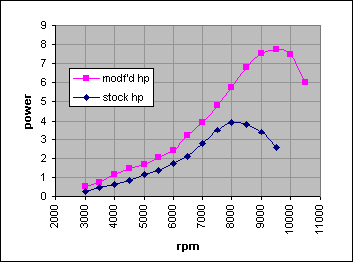Before jumping into how to do it, it's necessary to understand
what the clutch does and why it was designed that way to begin
with. The automatic CVT, or continuously variable transmission, is
a cousin of your typical multi-speed, constant-mesh, gear-driven
manual gearbox. Whereas the manual trans requires proper selection
of the gear ratio to maintain power, the automatic trans does the
thinking for the rider. Of course, for novice riders the auto trans
is a huge advantage in simplifying the riding experience. No
worrying about stalling the engine, or keeping it in the right
gear- it's all done magically by the CVT. However, unlike the CVT's
other cousin, the automotive style automatic transmission, the CVT
is designed very cleverly to continuously vary the transmission
gear ratio to do one thing only- hold the engine speed
constant.
The question becomes- if you were limited to
operating your engine at only one rpm, what would it be? The rpm at
which peak power occurs, of course, and therein lies the beauty of
the CVT transmission- it's ability to hold the engine there. The
job of the clutch tuner is to identify that point and dial it
in. This concept is key, and the crux
to the whole tuning exercise. If you were to examine the power
curve of a typical 2-cycle engine it would rise, and then fall very
quickly near its power peak- hence the notorious reputation of the
2-stroke as a "pipey" variety compared to the more docile and
predictable 4-stroke.
This concept is key, and the crux
to the whole tuning exercise. If you were to examine the power
curve of a typical 2-cycle engine it would rise, and then fall very
quickly near its power peak- hence the notorious reputation of the
2-stroke as a "pipey" variety compared to the more docile and
predictable 4-stroke.
When modifying your engine you've more
than likely shifted that peak power rpm. The original equipment
manufacturer (OEM) has probably optimized his gearing to coincide
with the stock machine’s peak power rpm. Without readjusting
the clutching to realign the controlled rpm with the new power
peak, full advantage of the engine mod may not be realized. In the
example above, the stock clutch would be adjusted to hold the
engine at 8000 rpm from the factory. If the clutch wasn't
readjusted to run at 9500 rpm, only a 50% improvement would be
gained since there's only another 1.7 hp available at 8000 rpm. Not
too shabby, but if the clutch was properly adjusted then max power
available to the quad would be nearly 100% higher, or
double!
Not to worry, most performance
shops will sell you their products with either recommendations for
a particular clutch setup, or provide the clutch hardware as part
of their kit. They've no doubt ran their own hardware and through
their own extensive testing have determined that a certain set of
rollers and spring result in the best performance. Realize though,
that there are subtle (and not so subtle) differences between
machines, and the recommended setup should only be considered a
starting point.


 Your Privacy Choices
Your Privacy Choices